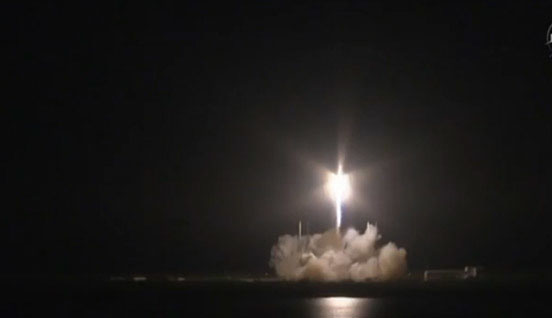After a setback earlier this week, SpaceX has successfully launched a Falcon9 rocket bound for the International Space Station (ISS) on a restocking mission. An attempt to land the potentially reusable rocket on a barge, however, failed.
The launch was conducted from the Cape Canaveral Air Force Station’s Space Launch Complex 40 in Florida at (9:50 GMT) early Saturday.
The rocket has a Dragon cargo ship on board, which is carrying some 5,000 pounds of science experiments, technology demonstrations and supplies to replace those lost following the explosion of an Antares rocket seconds after liftoff in October.
Among other important items of scientific research gear, the current Dragon spacecraft is set to deliver to the ISS the Cloud-Aerosol Transport System (CATS), a laser instrument to remotely measure atmospheric conditions from the space station, be it clouds, aerosols, dust, smoke, or pollution particulates.
According to NASA, the Dragon cargo ship will remain attached to the ISS’ Harmony module for more than four weeks before swan diving into the Pacific Ocean, just off the coast of Baja, California.
SpaceX was also aiming to make history by landing its Falcon 9 rocket on a floating platform off the coast of Jacksonville. The California-based firm has outfitted the first stage of the Falcon 9 rocket with landing legs and steering fins designed to fly the booster to its target.
Attempts to bring the booster’s first stage safely back to the ground failed, however, failed.
“Rocket made it to drone spaceport ship, but landed hard. Close, but no cigar this time,” Elon Musk, founder and chief executive of SpaceX, wrote on twitter.
He remained optimistic though, saying the attempt “bodes well for the future.”
The attempt was part of a broader cost cutting strategy to develop a reliable reusable rocket technology within years.
“Reusability is the critical breakthrough needed in rocketry to take things to the next level,” SpaceX founder Musk said at the MIT AeroAstro Centennial Symposium in October.
Prior to Saturday’s failure, there had been two test soft landings of the rocket booster performed in the ocean. Those attempts were also a no go, with Musk saying after standing straight on the barge for several seconds, the booster “tipped over and exploded.”
“It’s as tall as a 14-story building. When a 14-story building falls over, it’s quite a belly flop!” Musk said.
Musk had said the odds of landing the booster on Saturday were 50-50.
Saturday’s flight, dubbed Commercial Resupply Services 5 (CRS-5), is the fifth of a dozen planned Dragon delivery missions by SpaceX under a $1.6 billion contract with NASA.
R T
Maher Taki

